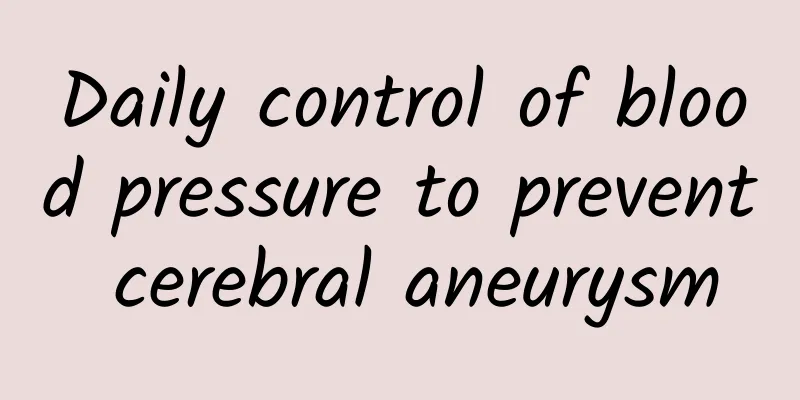Daily control of blood pressure to prevent cerebral aneurysm

|
Have you heard of the "silent killer" in the brain? It is a cerebral aneurysm. It is not a solid tumor, but a bulge somewhere in the wall of the blood vessel in the brain that cannot withstand the blood pressure. It can be understood as a "small balloon" in the blood vessel. Normally, the patient may not have any symptoms, but once it ruptures, it may cause severe cerebral hemorrhage, which is very dangerous. According to statistics, about 7% of adults in my country are at risk of aneurysms. Since aneurysms can be fatal, it is crucial to prevent the occurrence of aneurysms and to detect and treat them early. Hypertension is a major risk factor The formation of cerebral aneurysms is closely related to blood pressure. Hypertension is an important risk factor for aneurysm formation. Long-term hypertension can cause continuous mechanical pressure on the blood vessel wall, leading to changes in the structure of the blood vessel wall, a decrease in elastic fibers, and an increase in collagen fibers, making the blood vessel wall fragile and prone to aneurysm formation. In addition, hypertension may also promote vascular inflammatory response, further damage the blood vessel wall, and accelerate the development of aneurysms. How to control blood pressure 1. Monitor blood pressure: For people who do not have high blood pressure, it is also recommended to measure blood pressure regularly. You can use an electric blood pressure monitor at home and measure it in the morning or after sitting and resting for half an hour. The systolic blood pressure of a normal adult is between 90-140 mmHg and the diastolic blood pressure is between 60-90 mmHg. Older people or patients with long-term high blood pressure can monitor their personal basic blood pressure values according to the doctor's advice. If the blood pressure fluctuates greatly or is accompanied by symptoms such as dizziness and headache, seek medical attention in time. 2. Drug control of blood pressure: People who already suffer from hypertension should follow the doctor's advice for antihypertensive treatment, take antihypertensive drugs on time, and have regular check-ups; do not stop taking the drugs at will, and remember to monitor your blood pressure. 3. Healthy diet: Daily diet should be low in salt and fat; eat until 70% full and 80% full; it is recommended to pair fresh fruits and vegetables with appropriate amounts of grains; avoid overeating and irregular eating. 4. Emotional stability: Avoid large mood swings. Precautions in the diagnosis and treatment of aneurysms Brain aneurysms can be detected in time through examinations, and there are also corresponding treatments. You can consult a specialist for details. What you need to pay attention to during the diagnosis and treatment process is: 1. Drink more water and urinate more after DSA examination DSA examination is the gold standard for the examination of cranial aneurysms. DSA requires the injection of contrast agent into the blood vessels, so after the DSA examination, you need to drink more water and urinate more to expel the contrast agent as soon as possible! At the same time, stay in bed for 24 hours. There is only one needle eye wound during the examination, but because it is an artery, a compressor will be pressed on the wound to prevent bleeding. Please do not remove it by yourself. Medical staff will come to help you deal with it. 2. Do not play high-altitude and high-speed amusement facilities When conservative treatment is used for aneurysm patients, they should first use drugs to control blood pressure under the guidance of a doctor, and adopt a good lifestyle to control blood pressure. In addition, patients with aneurysm who are under conservative observation are not suitable for high-altitude work, nor can they play high-speed weightless amusement facilities. 3. You need to stay in bed after aneurysm embolization surgery For aneurysms that cannot be treated conservatively, minimally invasive aneurysm embolization or aneurysm clipping can be performed. Please consult a specialist for the specific surgical method. After the operation, you will need to stay in bed for 24-48 hours because you will need to use vasodilators or anticoagulants intravenously. If the coagulation results and other auxiliary examination results are normal, you can gradually get out of bed and move around. At the same time, intravenous anti-vasospasm drugs or anticoagulants, and anti-epilepsy drugs will be replaced with oral drugs. Please take them correctly according to the instructions of the medical staff. In short, the primary factor in avoiding aneurysm rupture is to take good care of the cardiovascular system, avoid high blood pressure, and have regular check-ups. |
<<: Recurrent oral ulcers may pose a serious threat
>>: If you want to supplement calcium with bone soup, you need to drink at least 100 bowls a day
Recommend
What can women eat to get better quickly from anemia?
Anemia in women is usually caused by iron deficie...
What are the tips for treating vulvar leukoplakia?
Vulvar leukoplakia is a common gynecological dise...
Can you get pregnant a few days before your period?
Every female friend has a special period in a mon...
What are the symptoms of genital herpes in women
Whether it is us humans or other species, we all ...
Sudden dizziness during 7 months of pregnancy
Many pregnant women experience dizziness, nausea ...
What causes dryness and pain in the lower body?
In fact, in modern society, women are under great...
Black color for the first menstrual period after abortion
I believe that if friends do not want children or...
What is causing the pain on the right side of my lower abdomen?
The most common disease for many women is abdomin...
Lips always peeling? What to do?
Do you have the problem of repeated lip peeling? ...
Formula for calculating fetal weight during pregnancy
Many pregnant women are very cautious in the late...
Can breasts be enlarged by kneading?
Some people think that their breasts will get big...
Is lower abdominal pain a gynecological inflammation?
The lower abdomen of women is a relatively sensit...
Can I eat chrysanthemum during menstruation?
Menstruation is a very important period of time f...
Is it OK for women to wear bras when exercising?
Exercise is an activity that we must do in our da...









